The Aerospace History Blog - Page 03

Post 018
At Peenmunde at the Baltic Coast, a Taifun is loaded into the
launching rack. (click to enlarge - the file may not be modified
- commercial use is prohibited.)
“Taifun” the unguided anti-aircraft rocket
The Luftwaffe had wasted two years fighting the Allied bombers when
development of guided anti-aircraft missiles was halted in late 1942.
Adolf Hitler relied on conventional anti-aircraft guns.
In autumn 1944, development was quickly resumed. When the control
of the rockets proved to be too difficult, the engineer from
Peenemunde, Klaus Scheufelen, invented the unguided rocket Taifun.
It was supposed to be shot at bombers in large numbers and fly at
supersonic speed. There were two versions, one with liquid fuel and
one with solid fuel. Test versions were produced, but the Taifun was
not used in combat.

Posted by Uwe W. Jack

For comparison, a soldier gives the size for the
Taifun rocket.
(click to enlarge - the file may not be modified -
commercial use is prohibited.)
Post 019
A look into the Japanese Shuttle Hope-X, taken from the NASDA brochure
from the year 2000.
A Japanese hope that did not come true
Since the late 1980s, Japan worked on developing a small unmanned
space transporter. Experimental models were launched on ballistic
trajectories in 1994 and 1996. The shuttle H-2 was supposed to
supply the space station ISS with cargo.
The small version Hope-X was designed as a test model. In the
brochure from 2000, the Japanese are still very optimistic that their
project will be successful. Instead of launching the spacecraft with the
H-2 rocket, an airplane was also proposed as a launch platform.
In 2003 the development was stopped. The then newly founded JAXA
(Japan Aerospace Exploration Agency) stopped the work because the
costs got out of hand.

Posted by Uwe W. Jack

Japan presented its projected small Space
Shuttle Hope-X at the Berlin Airshow ILA in
the year 2000.
(click to see the brochure - the file may not
be modified - commercial use is prohibited.)
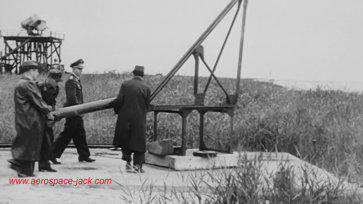
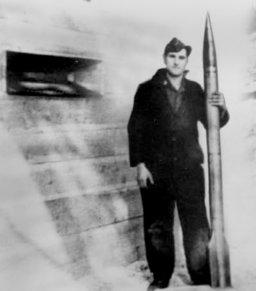

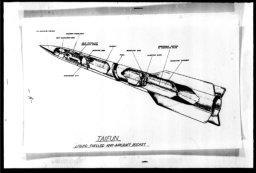
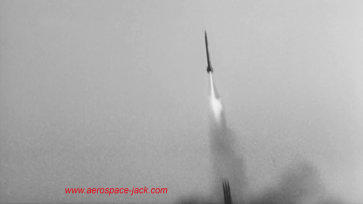
The Taifun roars into the sky. (click to enlarge - the file may
not be modified - commercial use is prohibited.)
You will find an allied report from 1946 on the Taifun and an
unpublished original drawing of this rocket in the “Docs and
Books” section. (click to jump to “Docs and Books”)
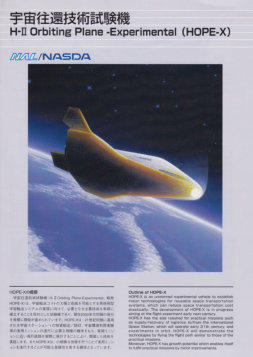

Post 020
With a Lufthansa airliner in the background, the Messerschmitt Taifun from the Lufthansa
heritage flight raised hopes in 1994 for a strong commitment of this airline in Berlin.
(click to enlarge - the file may not be modified - commercial use is prohibited.)
Old and new Lufthansa planes at Tempelhof
Older people will still remember that in the past you used to take
pictures with films, so the number of pictures was limited and you
received photo prints days later. I've done this for a few decades. The
legacy is several boxes full of photo prints. I am now sorting these and
either throwing them away or sticking them on paper and filing them
into folders. There are many memorabilia that appear.
Today there are pictures from the first airport show in Tempelhof in
1994 after the withdrawal of the American forces. The Messerschmitt
Bf 108 Taifun D-EBEI of Lufthansa and an airliner in Tempelhof was a
sign to many people at the time that Lufthansa would set up a strong
base again in Berlin. The Lufthansa Airline was founded here at
Tempelhof Airfield in 1926. Like so many other hopes during this
period, this has not come true.

Posted by Uwe W. Jack

Parked in front of the famous building of
Tempelhof airport, the Lufthansa
Messerschmitt Bf 108 was a exhibit of the
first german airshow in Berlin after the war.
(click to enlarge - the file may not be
modified - commercial use is prohibited.)
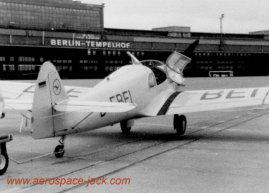
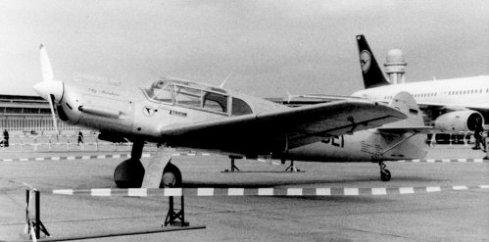
Post 021
The Astronaut’s last Flight
A photo of a Messerschmitt Bf 108 in my collection reminds me of a
very dramatic air show. In September 1995, the pioneering years of
aviation were brought back to life with biplanes at the former
Johannisthal airfield. The planes flew very close to the enthusiastic
spectators in mock combat. At the end of every 30-minute show, a
Messerschmitt Bf 108 Taifun D-EFPT flew a few maneuvers. The show
ended around 6 p.m. and I had used up my films.
The Taifun was now standing close to the barriers and the astronaut
Reinhard Furrer was leaning against the aircraft. We exchanged a few
words a week earlier after he gave a lecture. He nodded to me and
happily told me that he was about to fly the plane. I made a comment
that it was a lot better than the Space Shuttle in terms of elegance.
Then I went in the direction of the S-Bahn station. On the way I turned
around again and saw the Taifun approaching in the distance. On the
way to the train station again there were suddenly loud shouts and
sirens, a cloud of black smoke rose. A friend told me at the station that
the Taifun had flown a barrel roll, something had broken off the wing
and then the plane had crashed. The pilot, Gerd Kahdemann and
Reinhard Furrer died immediately. Later it turned out that the right
aileron went off.

Posted by Uwe W. Jack

Reinhard Furrer (1940 - 1995), the third
German in space, flew with Space Shuttle
Challenger in October 1985. In 1995 he was
Director of the Institute of Space Sciences at
the Freie Universität Berlin.
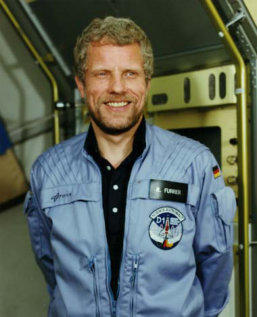


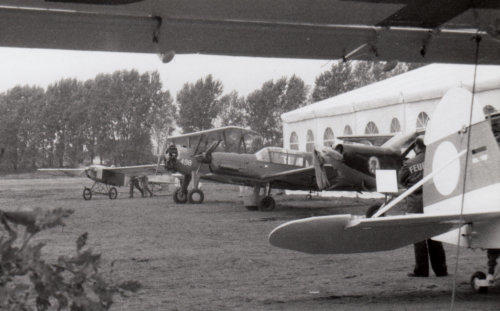
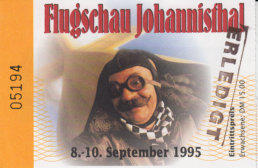
An optimistic aviator smiles on the ticket for
the Johannisthal airshow in 1995
Taken from a video, shown in the Berlin local tv-station SFB, the newspaper BZ published
this sequence how the aileron broke away from the Taifun’s right wing.
(click to enlarge - the file may not be modified - commercial use is prohibited.)

Post 022
Lufthansa Flight Plan 1929
Three years after the German domestic airline Lufthansa had been
founded at Tempelhof airport most Lufthansa destinations were in
Germany, but major European cities were also regularly served.
A flight from Berlin to London was possible for the price of 190
Reichsmark (RM).
Depending on how this sum is calculated, there are different prices
according to today's (2021) standard:
190 RM = 70 Dollar (58 Euro) based on relationship to the Dollar.
In 1929 a skilled worker earned around 1 RM per hour.
In 2021 in Germany this is between 15 to 23 Euro per hour.
This then adds up to a total price of 2850 to 4370 Euros (3430 to
5260 Dollar) for a one-way ticket Berlin-London.

Posted by Uwe W. Jack
In 1929 the complete Lufthansa flight plan
with prices could be printed on a single sheet
of paper.
(click to enlarge - the file may not be modified
- commercial use is prohibited.)

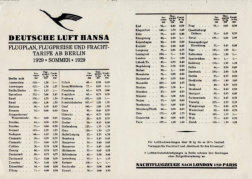
The Messerschmitt Taifun is parked in the background, visible under the wing of
a Fieseler Storch in the foreground. A few hours later the airplane took off on its
fatal final flight.
Post 023
Gerhard Barkhorn
The world's first fighter pilot to have flown more than 1,000 combat
missions. Gerhard Barkhorn (1919-1983) volunteered for the Luftwaffe
in 1938. He took part in the Battle of Britain - without getting a kill, but
was shot down twice himself. It was not until his 120th enemy flight on
July 2, 1941 that he was able to down an enemy - an Ilyushin DB-3.
Then everything went very fast. On December 19, 1942 he shot down
the 100th enemy, in August 1943 the 150th and in November the
200th. Barkhorn took off on his 1000th combat mission on January 23,
1944. On January 5, 1945 he scored his last aerial victory - number
301. This makes him the second most successful fighter pilot of all
time, behind Erich Hartmann (352). Completely exhausted, he was
then transferred to a new squadron in training and relieved of flight
service in April 1945.
Allied historians have carefully examined the combat reports and
found 300 to be completely correct and confirmed by witnesses. The
Luftwaffe confirmation from Berlin has not arrived for number 301
because the war ended. Barkhorn served in the West-German
Bundesluftwaffe after the war.
His Messerschmitt Bf 109 G was named after his fiancée Christl (his
wife from March 1942). Both were killed in a car accident in 1983.

Posted by Uwe W. Jack
Gerhard Barkhorn in November 1944.

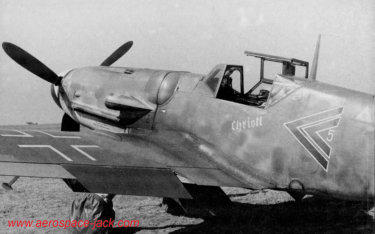
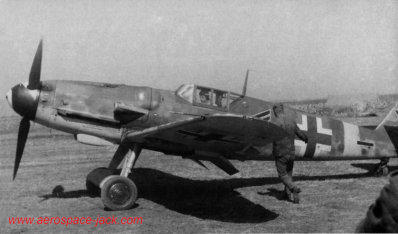
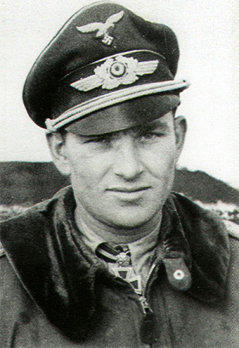

Gerhard Barkhorn prepares for another combat mission at the
Russian front in November 1943.
(click to enlarge - the file may not be modified - commercial use is
prohibited.)
His aircraft, a Messerschmitt Bf 109 G from Gruppenstab II/JG 52
was decorated with the name of his wife “Christl”.
(click to enlarge - the file may not be modified - commercial use is
prohibited.)
Post 024
The rebuild Argus-Schmidt 014 jet engine under full power in a test bunker
for miltary jets. (Click to see the video)
The simplest jet engine ever built.
In 1930 the Munich inventor Paul Schmidt submitted a patent for a
new type of jet drive to the German patent office. In 1931 the engine
and a special aircraft for it (that could hover in the air !) designed by
Schmidt were patented in the USA.
He offered his engine to the Luftwaffe and the Army. In the Army,
Wernher von Braun, working on rocket engines, judged Paul
Schmidt's invention to be very promising.
It could not be used on airplanes because of the strong acoustic
exposure (140 Phon). But the Fieseler company designed a small
unmanned missile powered by Paul Schmidt's engine: the V-1.
Developed from 1942 onwards, approximately 31,000 V-1 missiles
were built. The engine had been improved by the Berlin company
Argus, so it was called Argus-Schmidt 014. The production of an
engine took about 40 hours. It delivered 400 kp of thrust and had a
lifespan of up to an hour.
In Berlin, the working group "Daedalus" built and tested functional
Argus-Schmidt 014. The free video of the tests can be viewed on
youtube.com.

Posted by Uwe W. Jack

In the USA, Paul Schmidt filed the patent
1,983,405 at April, 15, 1931:
“Method of Producing Motive Forces on
Aircraft by the Explosion of Inflammable
Mixtures of Substances”
(click to find the full patent in the “docs”
section)
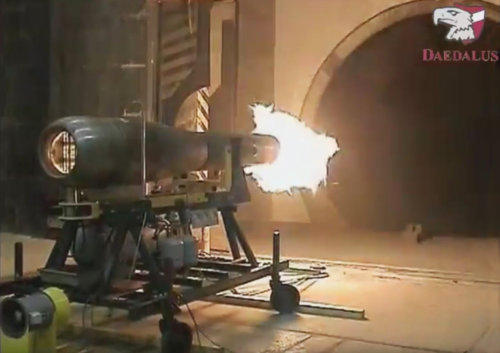
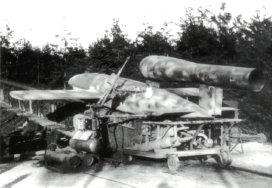
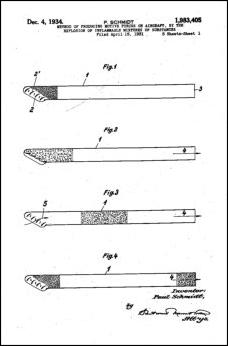

A V-1 missile ready for take off. The equipment to
move the V-1 down the catapult is under the tail.











